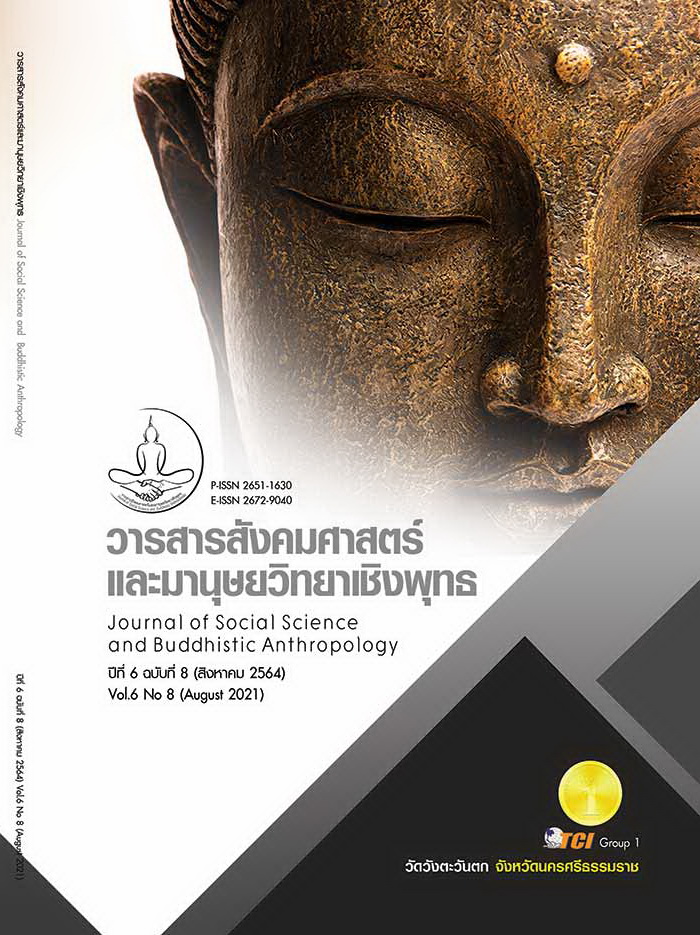STRUCTURAL EQUATION MODEL OF FACTORS INFLUENCING PERFORMANCE OF COMMUNITY ENTERPRISES
Keywords:
Community Enterprise, Transformational Leadership, Learning and Growth, Internal Processes, PerformanceAbstract
The objectives of this research article were to analyze the structural equation model of factors influencing the performance of community enterprises in Surat Thani Province and to study the guidelines for development of community enterprise in Surat Thani Province for continuous improvement in performance. This research utilized a mixed method approach. The quantitative research consisted of 520 samples using stratified sampling. Data were collected from the chair, vice president and directors of the community enterprise using questionnaires. The data were analyzed by structural equation model. The qualitative research collected data from key informants - chairman, vice president and director of the community enterprise - focus group of 16 people, divided into 2 groups of 8 people each and in-depth interviews of 8 people. Using semi-structured interviews and data analysis with content analysis. The results were found that the developed model consisted of four latent variables: transformational leadership, learning and growth, internal processes and performance that were consistent with empirical data a good - fit (X2/df = 1.980, RMSEA = 0.047, CFI = 0.990, SRMR = 0.033). The guidelines for the development of community enterprise in Surat Thani Province for continuous improvement in performance, namely 1) community enterprise leaders should have a transformational leadership model 2) strong learning and growth 3) internal processes must be ready to provide customer service under corporate social responsibility 4) performance according to the target and 5) operations according to the strategy map community enterprises must pay attention to various dimensions In the strategy map of community enterprises.
References
กองส่งเสริมวิสาหกิจชุมชน กรมส่งเสริมการเกษตร. (2563). สรุปจำนวนวิสาหกิจชุมชนและเครือข่ายวิสาหกิจชุมชนที่อนุมัติการจดทะเบียนแล้วจำแนกตามประเภทกิจการ จังหวัด สุราษฎร์ธานี. เรียกใช้เมื่อ 10 กุมภาพันธ์ 2563 จาก http://smce.doae.go.th /smce1/report/report_smce_activity.php
ปลื้มใจ ไพจิตร และชาญวิทย์ ทองโชติ. (2560). กระบวนการบริหารที่ส่งผลต่อประสิทธิผลวิสาหกิจชุมชน กลุ่มแปรรูปและผลิตอาหาร จังหวัดสุราษฎร์ธานี. วาสารวิทยาการจัดการ, 4(2), 175 - 204.
ไพศาล มุ่งสมัคร และคณะ. (2556). รูปแบบการจัดการที่ประสบผลสำเร็จของกลุ่มเครือข่ายวิสาหกิจชุมชน ผลิตภัณฑ์สมุนไพร กลุ่มจังหวัดนครชัยบุรินทร. วารสารสมาคมนักวิจัย, 18(3), 115 - 123.
สำนักงานคณะกรรมการพัฒนาเศรษฐกิจและสังคมแห่งชาติ. (2559). แผนพัฒนาเศรษฐกิจและสังคมแห่งชาติ ฉบับที่ 12 พ.ศ. 2560 - 2564. เรียกใช้เมื่อ 1 ธันวาคม 2562 จาก http://planning.dld.go.th/th/images/stories/section-5/2561/strategy03.pdf
สำนักงานส่งเสริมวิสาหกิจขนาดกลางและขนาดย่อม. (2563). รายงานสถานการณ์วิสาหกิจขนาดกลางและขนาดย่อม. เรียกใช้เมื่อ 22 ตุลาคม 2563 จาก https://www.sme.go.th /upload/mod_download/download-20200824164414.pdf
Arasti, R. et al. (2012). Exploring the Effect of Individual Factors on Business Failure in Iranian New Established Small Businesses. International Business Research, 5(4), 2-11.
Arif, S. & Akram, A. (2018). Transformational Leadership and Organizational Performance. SEISENSE Journal of Management, 1(3), 59 - 75.
Atan, J. & Mahmood, N. H. N. (2019). The role of transformational leadership style in enhancing employees’ competency for organization performance. Management Science Letters, 9(1), 2191 - 2200.
Athukorala, C. et al. (2016). The impact of transformational and transactional leadership styles on knowledge creation in Sri Lankan software industry. Retrieved February 10, 2020, from http://dl.lib.uom.lk/handle/123/11796
Benzing, C. et al. (2009). Entrepreneurs in Turkey: A Factor Analysis of Motivations, Success Factors, and Problems. Journal of Small Business Management, 47(1), 58-91.
Gray, D. et al. (2012). Success in challenging times: Key lessons for UK SMEs - Summary Report. Retrieved February 10, 2020, from https://www. researchgate.net/publication/237076800_Success_in_challenging_times_Key_lessons_for_UK_SMEs_-_Summary_Report
Kader, R. A. et al. (2009). Success factors for small rural entrepreneurs under the one-district-one-industry programme in Malaysia. Contemporary Management Research, 5(2), 147-162.
Kaplan, D. (2000). Structural Equation Modeling. CA: Sage Publications.
Kaplan, R. S. & Norton, D. P. (2004). The strategy map: guide to aligning intangible assets. Strategy & Leadership, 32(5), 10-17.
Kasim, T. et al. (2018). The Improvement of Business Efficiency Through Business Process Management. Journal of Economics and Business, 16(1), 31 - 43.
Kline, R. B. (2011). Principles and practice of structural equation modeling. (3rd ed.). NY: The Guilford Press.
Kumar, V. & Sharma, R. R. K. (2018). Leadership styles and their relationship with TQM focus for Indian firms: An empirical investigation. International Journal of Productivity and Performance Management, 67(6), 1063-1088.
Lucianetti, L. (2010). The impact of the strategy maps on balanced scorecard performance. International Journal of Business Performance Management, 12(1), 21-36.
Lussier, R. N. & Halabi C. E. (2010). Three-Country Comparison of the Business Success versus Failure Prediction Model. Journal of Small Business Management, 48(3), 360-377.
Mittal, S. & Dhar, R. L. (2015). Transformational leadership and employee creativity: mediating role of creative self-efficacy and moderating role of knowledge sharing. Management Decision, 53(5), 894-910.
Nielsen, S. & Nielsen, E. H. (2015). The Balanced Scorecard and the Strategic Learning Process: A System Dynamics Modeling Approach. Advances in Decision Sciences, 1(1), 1 - 20.
Niven, P. R. (2003). Balanced scorecard step-by-step for government and nonprofit agencies. NJ: John Wiley & Sons, Inc.
Pasban, M. & Nojedeh, S. H. (2016). A Review of the Role of Human Capital in the Organization. Social and Behavioral Sciences, 230(1), 249 - 253.
Rad, A. A. (2016). Construction Industry: A Review of Transformational and Transactional Leadership and Multifactor Leadership Questionnaire. International Journal of Innovative Research in Science, Engineering and Technology, 5(12), 20268 - 20272.
Schumacker, R. E. & Lomax, R. G. (2010). A beginner’s guide to structural equation modeling. (3rd ed.). NJ: Lawrence Erlbaum Associates.
Simpson, M. et al. (2012). Towards a new model of success and performance in SMEs. International Journal of Entrepreneurial Behaviour and Research, 18(3), 264-285.
Su, F. et al. (2019). Multilevel Impacts of Transformational Leadership on Service Quality: Evidence from China. Front. Psychol, 10(1252), 1 - 11.
Sujová, A. & Marcineková, K. (2015). Improvement of Business Processes – a Research Study in Wood - a processing Companies of Slovak. Procedia Economics and Finance, 34(1), 296 - 302.
Vázquez, D. G. et al. (2019). Corporate Social Responsibility and Intellectual Capital: Sources of Competitiveness and Legitimacy in Organizations Management Practices. Sustainability, 11(5843), 1 - 28.
Wali, A. F. (2013). Information Technology Infrastructure and Customer Service Delivery. British Journal of Marketing Studies, 1(2), 17-32.
Wiersma, W. & Jurs, S. G. (2009). Research Methods in Education an Introduction. (9th ed.). MA: Pearson Education Inc.
Zhang, Y. et al. (2018). How Does Transformational Leadership Promote Innovation in Construction? The Mediating Role of Innovation Climate and the Multilevel Moderation Role of Project Requirements. Sustainability, 10(1506), 1 - 19.








